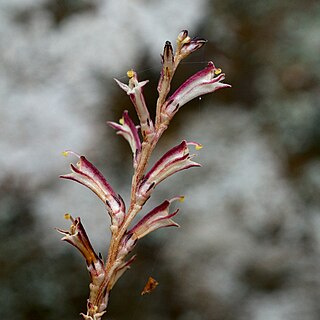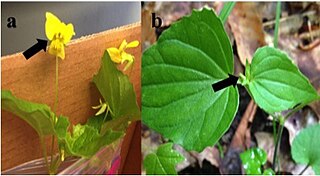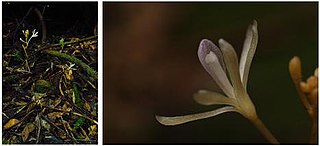
The Orchidaceae are a diverse and widespread family of flowering plants, with blooms that are often colourful and fragrant, commonly known as the orchid family.

Pollination is the transfer of pollen from a male part of a plant to a female part of a plant, later enabling fertilisation and the production of seeds, most often by an animal or by wind. Pollinating agents are animals such as insects, birds, and bats; water; wind; and even plants themselves, when self-pollination occurs within a closed flower. Pollination often occurs within a species. When pollination occurs between species it can produce hybrid offspring in nature and in plant breeding work.

Self-pollination is when pollen from the same plant arrives at the stigma of a flower or at the ovule. There are two types of self-pollination: in autogamy, pollen is transferred to the stigma of the same flower; in geitonogamy, pollen is transferred from the anther of one flower to the stigma of another flower on the same flowering plant, or from microsporangium to ovule within a single (monoecious) gymnosperm. Some plants have mechanisms that ensure autogamy, such as flowers that do not open (cleistogamy), or stamens that move to come into contact with the stigma. The term selfing that is often used as a synonym, is not limited to self-pollination, but also applies to other types of self-fertilization.

Petrosaviaceae is a family of flowering plants belonging to a monotypic order, Petrosaviales. Petrosaviales are monocots, and are grouped within the lilioid monocots. Petrosaviales are a very small order of photosynthetic (Japonolirion) and rare leafless achlorophyllous, mycoheterotrophic plants (Petrosavia) found in dark montane rainforests in Japan, China, Southeast Asia and Borneo. They are characterised by having bracteate racemes, pedicellate flowers, six persistent tepals, septal nectaries, three almost distinct carpels, simultaneous microsporogenesis, monosulcate pollen, and follicular fruit.

Monotropa uniflora, also known as ghost plant, ghost pipe or Indian pipe, is an herbaceous perennial plant native to temperate regions of Asia, North America and northern South America, but with large gaps between areas. The plant is sometimes completely waxy white, but often has black flecks or pale pink coloration. Rare variants may have a deep red color.

A flower, sometimes known as a bloom or blossom, is the reproductive structure found in flowering plants. The biological function of a flower is to facilitate reproduction, usually by providing a mechanism for the union of sperm with eggs. Flowers may facilitate outcrossing resulting from cross pollination or allow selfing when self pollination occurs.
Cleistogamy is a type of automatic self-pollination of certain plants that can propagate by using non-opening, self-pollinating flowers. Especially well known in peanuts, peas, and pansy this behavior is most widespread in the grass family. However, the largest genus of cleistogamous plants is Viola.

Epifagus virginiana, commonly called beech drops, is an obligate parasitic plant which grows and subsists on the roots of American beech. It is a member of the family Orobanchaceae. The genus Epifagus is monotypic—containing only E. virginiana. The name Epifagus derives from Greek "epi" meaning "on" or "upon", and "Fagus" which is the genus name of beech.

Chasmogamy, is a plant reproductive mechanism in which pollination occurs in chasmogamous flowers. Chasmogamous flowers are commonly showy with open petals encircling exposed reproductive parts. Chasmogamous stems from Greek for "open marriage", named after the open arrangement of floral structures. Once chasmogamous flowers have reached maturity, they unfurl and their stamens and/or style are made available for pollination. Although some plant species possess self-fertilizing chasmogamous flowers, most chasmogamous flowers are cross-pollinated by biotic or abiotic agents.

Lacandonia is a mycoheterotrophic plant that contains no chlorophyll and has the unusual characteristic of inverted positions of the male (androecium) and female (gynoecium) floral parts, something that had not been seen in any other plants with the occasional exception of some individuals of the related Triuris brevistylis.

Polygala lewtonii is a rare species of flowering plant in the milkwort family known by the common name Lewton's polygala, or Lewton's milkwort. It is endemic to Florida in the United States, where it is limited to the central ridge of the peninsula. There are about 49 occurrences of the plant remaining. Most occurrences contain very few plants. The species is threatened by the loss and degradation of its habitat. This is a federally listed endangered species of the United States.

Gastrodia sesamoides, commonly known as cinnamon bells or common potato orchid in Australia and as the pot-bellied orchid or cinnamon sticks in New Zealand, is a leafless, terrestrial saprophytic orchid in the family Orchidaceae. It has a thin, fleshy brown flowering stem and up to twenty five drooping, brownish, self-pollinating flowers that are white inside. Growing in a wide range of habitats, it is native to Australia and New Zealand.

Kummerowia stipulacea is a species of flowering plant in the legume family known by the common name Korean clover. It is native to China, Japan, Korea, and Russia, and it is present in the eastern United States as an introduced species.

Kummerowia striata is a species of flowering plant in the legume family known by the common names Japanese clover and common lespedeza. It is native to much of Asia and it is present in the eastern United States as an introduced species.

Oxalis montana is a species of flowering plant in the family Oxalidaceae known by the common names mountain woodsorrel, wood shamrock, sours and white woodsorrel. It may also be called common woodsorrel, though this name also applies to its close relative, Oxalis acetosella.

Lecanorchis tabugawaensis is a species of orchid which belongs to the group of mycoheterotrophic plants. Mycoheterotrophs are known for feeding off of the roots of fungal hosts, instead of utilizing photosynthesis. Myco-heterotrophy refers to the harmonious relationship between particular plants and fungi. After a thorough exploration of the plant's shape, size, and structure, it was determined to be closely associated with orchidaceous Lecanorchis amethystea, although inward variations confirmed this unique species.
Caladenia cleistantha is a plant in the orchid family Orchidaceae and is endemic to the south-east of Australia. It is a ground orchid which occurs as solitary plants and has a singly hairy leaf and one or two cleistogamous flowers..
Gastrodia amamiana is a species of mycoheterotrophic orchid in the family Orchidaceae found in Amami-Oshima and Tokunoshima islands, in Japan. The species was first described in 2019, when Kenji Suetsugu of the Kobe University together with independent scientists Hidekazu Morita, Yohei Tashiro, Chiyoko Hara and Kazuki Yamamuro, came across the flower during a flora survey of the islands’ evergreen forests. The species is cleistogamous, and bears fruit without opening its flower.
Gastrodia spatulata is a species of Gastrodia native to Indonesia and Malaysia. It is known from Borneo and Java.
Rhizanthella speciosa is a species of flowering plant in the orchid family and is endemic to Barrington Tops in New South Wales. It is a mycoheterotrophic herb that spends its entire life cycle, including flowering, at or below the soil surface. As at September 2020, R. speciosa has not yet been accepted as a valid name by the World Checklist of Selected Plant Families or the Australian Plant Census.














